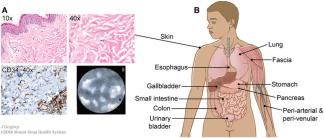Scientists say they’ve discovered a new human organ, and it might be the biggest
Interstitium: Scientists say they've discovered a new human organ
The interstitium was right there under our noses (and skin) all along, but it took a new way of examining tissues to figure it out.
Scientists said in a study published Tuesday that they may have stumbled on a previously unknown organ — one of the biggest in the human body and one that could significantly advance our understanding of cancer and many other diseases.
The research, published in the journal Scientific Reports, suggests that a network of dense connective tissues and fluid-filled compartments called the interstitium is a full-fledged organ — that is, a group of tissues with a unique structure performing a specialized task, like the heart or the liver.
More than two-thirds of the human body is water, most of that contained inside cells. Much of the rest, about 20 percent of the fluid in the body, is "interstitial," a Latin word combining "inter," or "between," and "sistere," or "to place" — literally, "between the other places."

That fluid and the tissues connecting them are called the interstitium (pronounced "inter-STISH-um"), and they're found throughout the body, both just below the skin and in the digestive, respiratory and urinary systems.
Whether the interstitium is an actual separate organ remains to be determined by further research. Either way, its understanding means "a significant reassessment of anatomy affecting every organ of the body," said one of the lead authors, Neil D. Theise, a pathology professor at Langone Medical Center at New York University.
Understanding the interstitium could be particularly significant in diagnosing and tracking the spread of cancers and other diseases that spread throughout the body. Interstitial fluid is the source of lymph, which dispatches white blood cells, the body's immune system infection fighters, to wherever they're needed.
Related
A federal panel of elite scientists reported in 2016 that focusing on the immune systemcould be the key to finding highly effective treatments for cancer. Theise said in an interview that the new research can be seen as parallel to that work; moreover, because the interstitium is found throughout the body, understanding it could have implications for an impossible-to-predict range of systems from head to toe.
"You push the first domino down and when you look up to see where the dominoes have fallen, you realize they've spread out everywhere," he said.
'IT'S JUST THERE'
The interstitium has been hiding right under scientists' noses all along, but it took an accident to figure out what it really is.
"There are no pictures of it. There are no illustrations of the construct," Theise said. "It's just there."
No one saw the "in between" spaces before because the way scientists traditionally examine human tissue (by slicing it and treating it with chemicals) drains away its fluids. Interstitial tissues handled that way throw off all of their fluids and, in essence, pancake like the floors of a collapsed building.
Related
Theise said interstitial tissues usually appear flat and solid under a microscope, rather than as the fluid-filled sacs they actually are.
In 2015, doctors called endoscopists, who peer inside the body using long, flexible tubes with cameras on them, found something strange when they were using a new technology that adds a laser and a tiny microscope to light up living tissues inside a patient's bile duct. Such examination is described as "in vivo," meaning it takes place inside a living organism, rather than on dead tissue on a slide.
The endoscopists, David Carr-Locke and Petros Benias of Mount Sinai Beth Israel, the acclaimed teaching hospital in New York, noticed a series of interconnected cavities that didn't match any known anatomy, according to the paper. They took their images to Theise, and together, they determined that what had appeared to be small torn spots in traditional biopsy slides were actually the remnants of those collapsed compartments.
"Those cracks are not artifacts," Theise said Tuesday. "They're the space where the fluid was."





No comments